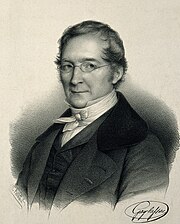Joseph Louis Gay-Lussac
Joseph Louis Gay-Lussac | |
|---|---|
 Joseph Louis Gay-Lussac | |
| Born | December 6, 1778 |
| Died | May 9, 1850 |
| Nationality | French |
| Known for | Gay-Lussac's law |
| Scientific career | |
| Fields | chemist |
Joseph Louis Gay-Lussac (also Louis Joseph Gay-Lussac, December 6, 1778 – May 9, 1850) was a French chemist and physicist. He is known mostly for two laws related to gases, and for his work on alcohol-water mixtures, which led to the degrees Gay-Lussac used to measure alcoholic beverages in many countries.
Biography
Gay-Lussac was born at Saint-Léonard-de-Noblat in the department of Haute-Vienne. He received his early education at home, and in 1794 was sent to Paris to prepare for the École Polytechnique after his father was arrested, and into which he was admitted at the end of 1797. Three years later, Gay-Lussac transferred to the École des Ponts et Chaussées, and shortly afterwards was assigned to C. L. Berthollet as his assistant. In 1802, he was appointed demonstrator to A. F. Fourcroy at the École Polytechnique, where in (1809) he became professor of chemistry. From 1808 to 1832, he was professor of physics at the Sorbonne, a post which he only resigned for the chair of chemistry at the Jardin des Plantes. In 1831 he was elected to represent Haute-Vienne in the chamber of deputies, and in 1839 he entered the chamber of peers.
Gay-Lussac married Geneviève-Marie-Joseph Rojot in 1809. He had first met her when she worked as a linen draper's shop assistant and was studying a chemistry textbook under the counter. He fathered five children, of whom the eldest (Jules) became assistant to Justus Liebig in Giessen. Some publications by Jules are mistaken as his father's today since they share the same first initial (J. Gay-Lussac).
Joseph Louis Gay-Lussac died in Paris, and his grave is there at the Père Lachaise cemetery.
Some of Gay-Lussac's descendants live in Brazil, South America (de Salusse Lussac/Lussac Do Coutto/Do Coutto Monni) and in Ontario, Canada.
Achievements

- 1802 - Gay-Lussac first formulated the law stating that if the mass and pressure of a gas are held constant then gas volume increases linearly as the temperature rises. This is sometimes written as V = k T, where k is a constant dependent on the type, mass, and pressure of the gas and T is temperature on an absolute scale. (In terms of the ideal gas law, k = n R / P.)
- 1804 - He and Jean-Baptiste Biot made a hot-air balloon ascent to a height of 6.4 kilometres in an early investigation of the Earth's atmosphere. He wanted to collect samples of the air at different heights to record differences in temperature and moisture.
- 1805 - Together with his friend and scientific collaborator Alexander von Humboldt, he discovered that the basic composition of the atmosphere does not change with decreasing pressure (increasing altitude). They also discovered that water is formed by two parts of hydrogen and one part of oxygen (by volume).
- 1808 - He was the co-discoverer of boron.
- 1810 - In collaboration with Louis Thenard, he developed a method for quantitative elemental analysis by measuring the CO2 and O2 evolved by reaction with potassium chlorate.
- 1811 - Gay-Lussac recognized iodine as a new element, described its properties, and suggested the name iode.[1]
- 1824 - He developed an improved version of the burette that included a side arm, and coined the terms "pipette" and "burette" in an 1824 paper about the standardization of indigo solutions.[2]
- In Paris, a street and a hotel near the Sorbonne are named after him as are a square and a street in his birthplace, St Leonard de Noblat.
Academic lineage
{{Academia}} template profile URL and not present in Wikidata.
References
- "JOSEPH LOUIS GAY-LUSSAC (1778-1850)--PHYSICIST AND FIRE BALLOONIST". JAMA. 187. UNITED STATES: 771. 1964. ISSN 0098-7484. PMID 14094304.
{{cite journal}}: Check date values in:|year=(help); Cite has empty unknown parameters:|laydate=,|laysource=, and|laysummary=(help); Unknown parameter|month=ignored (help); Unknown parameter|quotes=ignored (help) - PARTINGTON, J R (1950). "J L. Gay-Lussac (1778-1850)". Nature. 165 (4201). Not Available: 708. ISSN 0028-0836. PMID 15416794.
{{cite journal}}: Check date values in:|year=(help); Cite has empty unknown parameters:|laydate=,|laysource=, and|laysummary=(help); Unknown parameter|month=ignored (help); Unknown parameter|quotes=ignored (help)
Further reading
- Gay-Lussac, L. J. and A. von Humboldt (1805) Expérience sur les moyens oediométriques et sur la proportion des principes constituents de l'atmosphère. J. Phys.-Paris LX.
- Maurice Crosland. Gay-Lussac, Scientist and Bourgeois, Cambridge University Press, Cambridge, 1978, 333p., ISBN 0521219795
External links
- Biographical material from the American Chemical Society
